The Ultimate Guide to AI Search Algorithms
Written By
Published On
Read Time

Artificial intelligence tools are all around us, and there's a good reason for that. They're capable of handling a wide range of tasks and solving many common problems. However, the effectiveness of these tools largely depends on the quality of their AI search algorithm.
Put simply, an AI search algorithm is like a set of instructions that an AI tool follows to figure out the best answer to a specific problem you have. These algorithms might prioritize different things, like speed or accuracy, depending on what's most important for the task. They consider what you're asking for and the goals you're trying to achieve, and then they come up with the solution they think is best.
By the end of this read, you'll get a good grasp of what AI search algorithms are and how they can be applied to improve your AI tools.
What are AI Search Algorithms?
AI search algorithms are the backbone of artificial intelligence, enabling machines to solve complex problems, navigate through vast data sets, and make decisions based on logical or heuristic analysis. These algorithms are designed to explore possible paths, configurations, or actions to find an optimal solution or to satisfy specific criteria. Understanding AI search algorithms is crucial for data scientists, as they are fundamental in developing intelligent systems that can perform tasks such as pathfinding, puzzle solving, optimization, and even playing games.
Uninformed Search Algorithms
Uninformed Search Algorithms do not have additional information about states beyond what is provided in the problem definition. Examples include:
Breadth-first Search (BFS)
Source: GeeksforGeeks
Breadth-first Search (BFS) is a quintessential algorithm in the landscape of AI search algorithms. It explores the search tree level by level, starting from the root node and expanding outward to all neighboring nodes. BFS systematically checks each level of the tree before moving on to the next, ensuring that the shortest path to the goal is found if one exists. This method is particularly effective in scenarios where the solution's depth is unknown, or the tree is significantly wide but not very deep.
AI Search Algorithms Examples with BFS: BFS is widely used in networking applications, such as finding the shortest path in routing protocols or in social networking services when searching for connections within a certain degree of separation.
Depth-First Search (DFS)
Depth-First Search (DFS) takes a different approach from BFS. Instead of exploring the search space level by level, DFS dives deep into one branch of the tree until it reaches a leaf node or a dead end before backtracking and exploring other branches. This algorithm is memory-efficient since it doesn't need to store all the sibling nodes in memory. DFS is particularly useful in scenarios where the solution paths are deep, and the search space is vast.
AI Search Algorithms Examples with DFS: DFS is commonly used in puzzle-solving applications, game playing scenarios for exploring possible moves, and in web crawlers for traversing the web.
Depth-Limited Search (DLS)
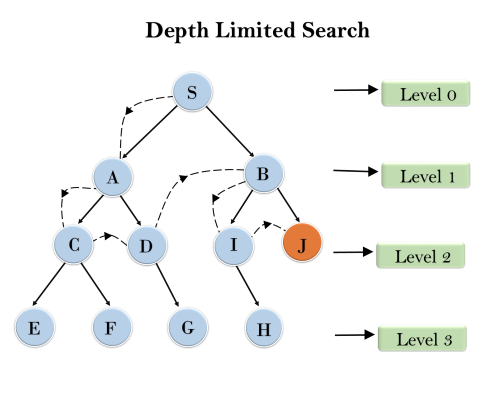
Source: JavatPoint
Depth-limited search (DLS) is a variant of DFS that introduces a limit to the depth the algorithm can explore. This limit prevents the search from going too deep into paths that are unlikely to yield a solution, effectively avoiding the problem of infinite loops in recursive paths. DLS is a compromise between the exhaustive nature of BFS and the depth-oriented approach of DFS, providing a controlled mechanism to explore the search space.
AI Search Algorithms Examples with DLS: DLS can be applied in scenarios where the depth of the problem space is large, but there's a need to constrain the search to avoid excessive computation, such as in certain types of puzzle games or optimization problems.
Iterative Deepening Search (IDS)
Source- GeeksforGeeks
Iterative Deepening Search (IDS) combines the space efficiency of Depth-First Search (DFS) with the completeness and optimality of Breadth-First Search (BFS). IDS systematically increases the depth limit of DFS until a solution is found, effectively performing multiple DFS traversals with increasing depth. This approach ensures that even if the search space is infinite, IDS can find the solution in a finite time if it exists. It's particularly useful in scenarios where the depth of the solution is unknown, making it a versatile choice among AI search algorithms.
Bi-directional Search (BDS)

Bi-directional Search (BDS) is an innovative approach that simultaneously searches forward from the initial state and backward from the goal state, hoping that the two searches meet in the middle. This technique can significantly reduce the search time by squaring the speed of the search process compared to traditional single-direction search methods. BDS is most effective when the path from the initial state to the goal state is unique or well-defined, making it a powerful tool in AI's arsenal for solving puzzles and navigation problems.
Uniform Cost Search (UCS)
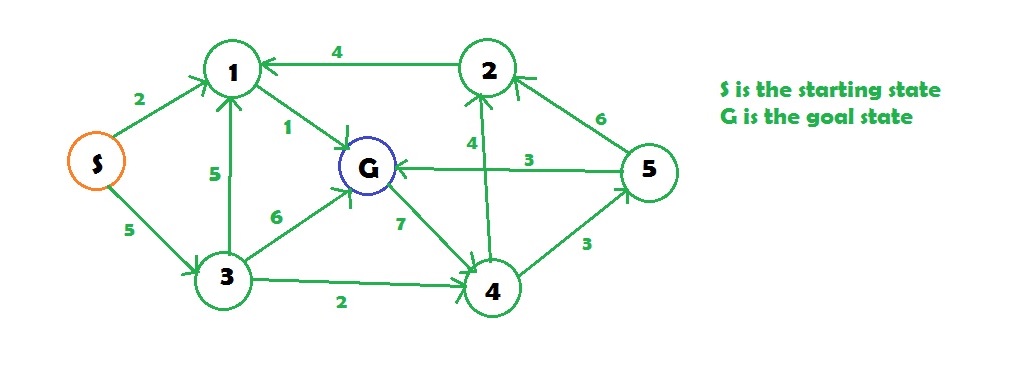
Uniform Cost Search (UCS) is a variant of the general search algorithm that considers the cost of each path to the next state. It prioritizes paths that have the lowest cumulative cost. UCS is complete and optimal, guaranteeing that the first solution found is the least costly path to the goal if one exists. It uses a priority queue to keep track of the frontier or the set of all leaf nodes available for expansion at any given point. UCS is particularly useful in weighted graphs where the costs between nodes vary, such as in routing and pathfinding problems in AI.
Informed Search Algorithms
Informed Search Algorithms, on the other hand, use heuristic functions to guide the search process toward the goal more efficiently. Examples include:
Greedy Search Algorithms
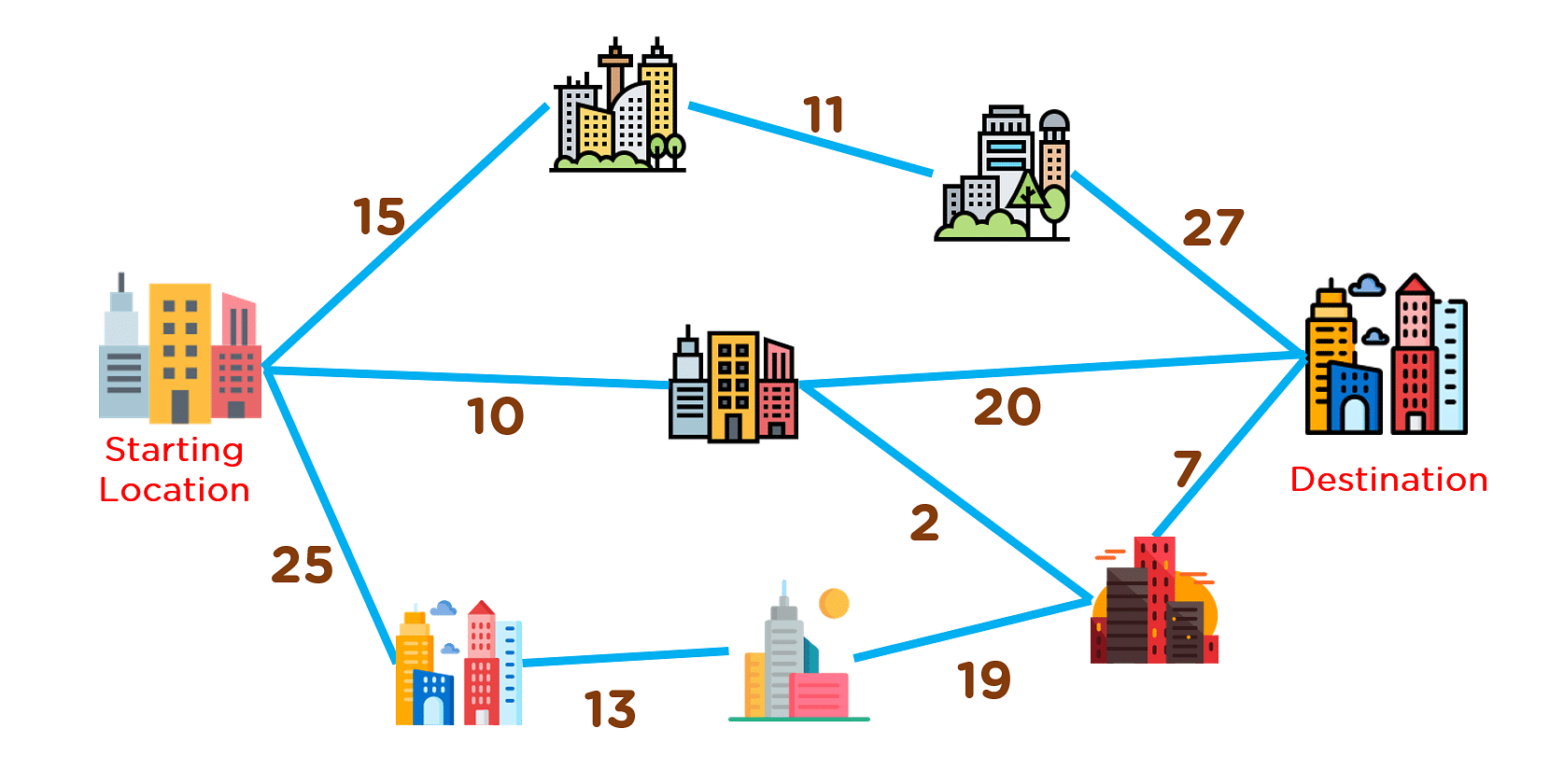
Source: Simplilearn
Greedy search algorithms represent a category of AI search algorithms that make decisions based on the most promising path forward at any given point without considering the long-term consequences. These algorithms prioritize moving towards the goal state as directly as possible, using a heuristic to estimate the cost from the current state to the goal. This approach can lead to efficient searches, quickly identifying a viable solution path. However, the primary drawback of greedy search algorithms is that they do not guarantee the optimal solution, as the immediate choice might not always lead to the best overall path. Despite this, in scenarios where speed is more critical than absolute optimality, greedy search algorithms serve as a powerful tool in the AI search algorithm arsenal.
A* Search Algorithms
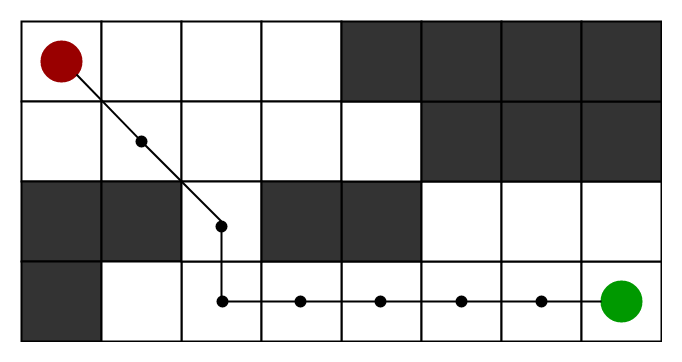
The A* (A-Star) search algorithm stands as a beacon of balance between efficiency and accuracy in the search algorithm domain. It combines the strengths of both greedy search algorithms and uniform cost search, making it one of the most popular search algorithms in AI. A* uses a heuristic function to estimate the cost from the current state to the goal, similar to greedy search, but it also considers the cost already incurred to reach the current state. This dual consideration allows A* to efficiently find the most cost-effective path to the goal. The beauty of A* lies in its versatility and reliability, as it guarantees an optimal solution if the heuristic function is admissible, meaning it never overestimates the actual cost to reach the goal.
Iterative deepening A* (IDA*)

Iterative Deepening A* (IDA*) combines the depth-first search's space efficiency and the heuristic-guided search of A* to create a powerful algorithm capable of handling large search spaces with limited memory. IDA* iterates through the search space, deepening the search incrementally until it finds the goal. At each iteration, it uses a cost threshold to decide which nodes to expand based on the estimated total cost (actual cost plus heuristic cost). This threshold increases with each iteration, allowing the algorithm to explore further into the search space progressively. IDA* is particularly useful in scenarios where the search space is vast and memory efficiency is paramount, offering a practical solution that balances resource usage with the ability to find an optimal path.
Local Search Algorithms
Hill Climbing
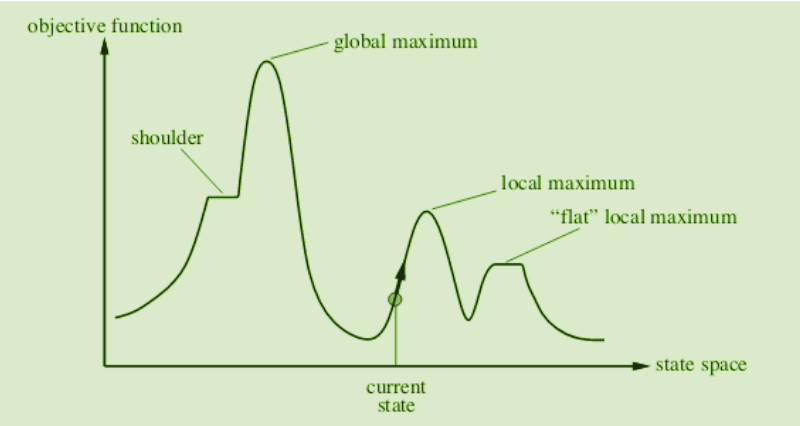
Hill Climbing is a metaphorical ascent towards the peak of optimization. It's a straightforward yet powerful approach among the types of search algorithms in AI, where the algorithm starts with a random solution and iteratively moves to a neighboring solution if the move offers an improvement. Think of it as a hiker who, in a thick fog, makes small steps toward higher ground, aiming to reach the top of the hill. However, Hill Climbing can sometimes get stuck in local maxima, points where all neighboring solutions are worse, but the solution isn't the best possible (global maximum). Despite this, its simplicity and ease of implementation make it a popular choice for many optimization problems.
Simulated Annealing

Source: Wikipedia
Simulated Annealing is inspired by the process of annealing in metallurgy. This sophisticated algorithm introduces randomness into the search process to escape the pitfalls of local maxima, akin to Hill Climbing. It allows for occasional moves to worse solutions under controlled conditions, thereby providing a chance to explore the solution space more broadly and potentially find a global optimum. The "temperature" parameter is key to its operation; high temperatures allow more exploration, while cooling the system gradually focuses the search on optimization. Simulated Annealing's ability to balance exploration and exploitation makes it highly effective for complex optimization problems.
WalkSAT
WalkSAT stands out in the landscape of local search algorithms in AI for its specialized application in solving Boolean satisfiability problems (SAT). It's a stochastic algorithm that combines local search with random jumps. WalkSAT starts with a random assignment of values to variables and iteratively flips the values of selected variables to satisfy more clauses of the Boolean formula. The algorithm decides whether to make a random flip or a strategic flip based on a probability parameter, allowing it to escape local optima and explore the solution space more effectively. This blend of randomness and strategy enables WalkSAT to efficiently find assignments that are satisfying even for large and complex SAT problems.
Genetic Algorithm
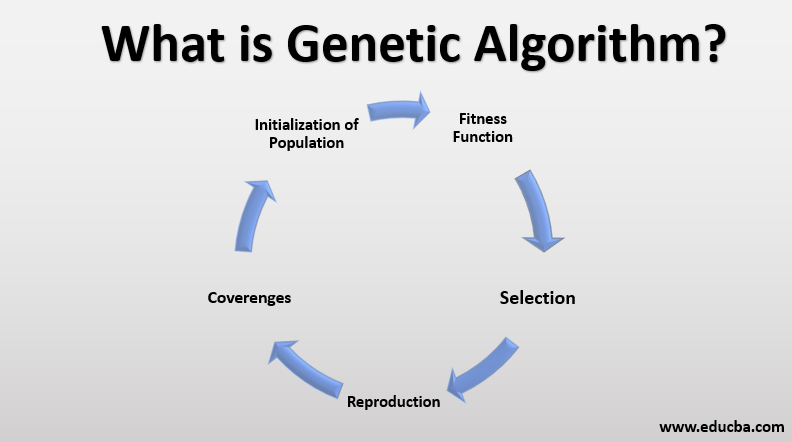
Source: EDUCBA
The Genetic Algorithm (GA) is inspired by the process of natural selection and genetics, embodying the principle of survival of the fittest. This algorithm starts with a population of potential solutions represented as chromosomes. It then applies genetic operators such as selection, crossover (recombination), and mutation to evolve the population over generations. The aim is to produce offspring that inherit the best traits from their parents, gradually moving towards an optimal solution.
Beam Search

Beam Search is a heuristic search algorithm that explores a graph by expanding the most promising nodes. It's a variant of the breadth-first search that maintains a limited number of best candidates at each level, known as the "beam width." By limiting the number of branches it explores, Beam Search strikes a balance between exploration and memory consumption, making it more efficient than exhaustive search methods.
Monte Carlo Tree Search (MCTS)

Monte Carlo Tree Search is a highly versatile search algorithm that combines the precision of tree search with the randomness of Monte Carlo methods. It builds a search tree incrementally by performing random simulations to explore the most promising moves. The results of these simulations are used to make informed decisions about which branches of the tree to explore more deeply.
Las Vegas Algorithm
The Las Vegas Algorithm is a fascinating example of AI search algorithms that rely on randomness to achieve their goals. Unlike deterministic algorithms, which follow a predictable path to a solution, the Las Vegas Algorithm incorporates random choices in its search process with the aim of finding a correct or optimal solution. The key characteristic of this algorithm is that it always produces a correct solution or reports a failure, but the time it takes to reach that solution can vary.
Atlantic City Algorithm
While not as commonly referenced as the Las Vegas Algorithm, the Atlantic City Algorithm represents a middle ground between deterministic and purely random approaches. It guarantees a probable approximation of the solution with a certain probability. This algorithm is designed to provide a balance between the predictability of deterministic algorithms and the randomness of Las Vegas-type algorithms, aiming for a good enough solution within a reasonable timeframe.
Applications of AI Search Algorithms
In the world of AI-powered content marketing, search algorithms play a crucial role in various aspects. The following sections delve into how these algorithms are applied in pathfinding, optimization, and game-playing to create engaging and successful content marketing strategies.
Pathfinding

One of the primary applications of search algorithms is pathfinding. This includes:
Determining the best content strategy: By analyzing data and patterns, AI search algorithms can help identify the most effective approach to content creation and distribution. This ensures that your content marketing efforts are targeted and well-executed.
Identifying relevant keywords and topics: Search algorithms can also assist in pinpointing the most relevant keywords and topics for your target audience. This helps create content that not only appeals to your audience but also ranks higher in search engine results.
Optimization
Beyond pathfinding, search algorithms can also contribute significantly to optimization in content marketing. This involves:
SEO optimization for content: AI search algorithms can analyze your content and provide recommendations on how to improve its search engine optimization (SEO). This can lead to higher visibility and more organic traffic for your website.
Maximizing return on investment: By leveraging search algorithms to create and optimize content, businesses can maximize their return on investment (ROI) in content marketing. This results in more engagement, conversions, and revenue.
Game Playing
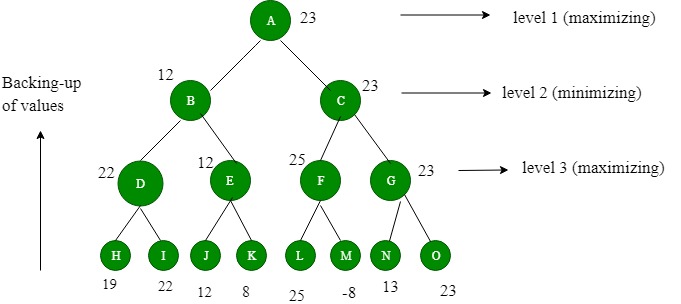
Lastly, search algorithms can be employed in game playing to make content marketing more interactive and enjoyable. This includes:
Engaging with the audience through interactive content: Using search algorithms, businesses can develop interactive content that actively engages users and keeps them on the website longer. Examples include quizzes, polls, and interactive infographics.
Implementing gamification in content marketing strategies: Gamification is the process of adding game-like elements to non-game situations, such as content marketing. Search algorithms can help create personalized and engaging gamified experiences that encourage users to interact with your content and brand.
Challenges of AI Search Algorithms
AI search algorithms are pivotal in navigating the vast and complex landscape of data to find optimal solutions to problems. These algorithms, ranging from simple linear searches to advanced heuristic-based methods, are fundamental in fields like machine learning, robotics, and data science. Despite their critical role, implementing AI search algorithms comes with its unique set of challenges. Understanding these challenges is essential for data scientists and AI practitioners to effectively leverage these algorithms in solving real-world problems.
Complexity and Computation Time
One of the primary challenges associated with AI search algorithms is managing complexity and computation time, especially with types of search algorithms in AI that explore large search spaces. Algorithms like A* or Dijkstra's algorithm, while efficient in finding the shortest path, can suffer from exponential time complexity in worst-case scenarios. This issue is exacerbated in problems with vast search spaces, where the algorithm must evaluate a multitude of possible paths or solutions. Balancing algorithm efficiency and computational feasibility becomes a critical concern for practitioners.
Heuristic Accuracy
Local search algorithms in AI, such as Simulated Annealing or Genetic Algorithms, rely heavily on heuristics to guide the search process towards optimal solutions. The challenge lies in designing accurate and reliable heuristics that can effectively approximate the distance to the goal or the quality of a solution. Inaccurate heuristics can lead to suboptimal solutions or, in the worst case, completely misguide the search process. Developing heuristics that are both informative and computationally efficient remains a significant challenge in AI search algorithms.
Handling Dynamic Environments
Many real-world applications of AI search algorithms operate in dynamic environments where the underlying data or conditions can change over time. Adapting search strategies to accommodate these changes without restarting the search process from scratch is a complex challenge. Algorithms must be designed with mechanisms to update their search paths or solutions in response to environmental changes, ensuring the relevance and accuracy of the solutions over time.
Scalability and Generalization
As AI applications grow in scope and complexity, search algorithms must scale accordingly. A major challenge is ensuring that these algorithms can handle increased problem sizes and complexity without a significant degradation in performance. Additionally, there's the challenge of generalization—designing AI search algorithms that are not just tailored to specific problems but can be applied across a range of scenarios. Achieving scalability and generalization requires innovative approaches to algorithm design and problem-solving strategies.
Balancing Exploration and Exploitation
AI search algorithms, particularly those used in optimization problems, face the challenge of balancing exploration (searching new areas of the search space) and exploitation (deepening the search around promising areas). Striking the right balance is crucial for finding global optima without getting trapped in local optima. Algorithms like Particle Swarm Optimization and Ant Colony Optimization exemplify this challenge, where the parameters controlling exploration and exploitation must be carefully tuned to the specific problem at hand.
Evaluating Search Algorithms
Understanding and evaluating AI search algorithms is crucial for data scientists and AI practitioners. Here, we delve into four critical aspects to consider when evaluating search algorithms in AI: completeness, time complexity, space complexity, and optimality.
Completeness
Completeness is a measure of an algorithm's ability to guarantee a solution if one exists. In the context of AI search algorithms, it's essential to know whether the algorithm can systematically explore all possible states or paths to find a solution. For example, Breadth-First Search (BFS) and Depth-First Search (DFS) are considered complete under certain conditions because they exhaustively search through all possible states. However, completeness can be a double-edged sword in vast search spaces, as it may lead to impractical execution times.
Time Complexity
Time complexity refers to the computational cost in terms of execution time as a function of the input size. It's a critical factor in evaluating AI search algorithms because it directly impacts the algorithm's efficiency and feasibility in real-world applications. Algorithms like BFS have a time complexity of O(b^d), where b is the branching factor, and d is the depth of the solution. Understanding time complexity helps in selecting the right algorithm based on the problem's nature and the available computational resources.
Space Complexity
Space complexity measures the amount of memory required by an algorithm during its execution. In AI search algorithms, space complexity is crucial because it determines the algorithm's scalability and its ability to handle large problem instances. For instance, DFS has a space complexity of O(bm), where m is the maximum depth of the search tree. This is generally lower than BFS, making DFS more suitable for problems with limited memory resources despite its potential drawbacks in other areas.
Optimality
Optimality assesses whether an algorithm can find the best solution among all possible solutions. It's particularly important in AI search algorithms when multiple solutions exist, and there is a need to identify the most efficient or cost-effective one. Algorithms like A* are designed to be optimal by incorporating heuristic functions that estimate the cost from the current state to the goal state, guiding the search towards the most promising paths. However, the choice of heuristic can significantly influence the algorithm's performance and optimality.
The Application of AI Search Algorithms To Solve Real-World Problems
The realm of Artificial Intelligence (AI) is vast and complex, with search algorithms sitting at its core, powering the ability to solve some of the most intricate real-world problems. AI search algorithms are designed to navigate through the labyrinth of possible options to find solutions efficiently and effectively. From optimizing logistics to enhancing medical diagnoses, the application of these algorithms demonstrates the profound impact AI can have on our daily lives.
Optimizing Logistics and Supply Chain Management
One of the most compelling applications of AI search algorithms lies in logistics and supply chain management. By employing types of search algorithms in AI, companies can optimize routes, reduce delivery times, and lower costs. For example, local search algorithms in AI have been instrumental in solving the Traveling Salesman Problem, where the goal is to find the shortest possible route that visits a list of locations and returns to the origin. This optimization leads to significant savings and efficiency improvements in transportation and delivery services.
Enhancing Medical Diagnoses
In the healthcare sector, AI search algorithms are revolutionizing the way medical diagnoses are conducted. Through the analysis of vast datasets of patient records and medical imagery, AI can identify patterns and anomalies that might be overlooked by the human eye. For instance, AI search algorithms examples include the use of algorithms to sift through thousands of MRI scans to detect early signs of diseases such as cancer, significantly improving the chances of successful treatment through early detection.
Improving Environmental Conservation Efforts
AI search algorithms also play a crucial role in environmental conservation. By analyzing satellite imagery and environmental data, AI can identify areas at risk of deforestation, illegal mining, or pollution spread. Local search algorithms in AI are particularly useful for monitoring wildlife populations and their movements, helping conservationists develop strategies to protect endangered species and preserve biodiversity.
Advancing Autonomous Vehicle Technology
The development of autonomous vehicles is another area where AI search algorithms are making a significant impact. These vehicles rely on a combination of AI search algorithms to process real-time data from their surroundings, make decisions, and navigate safely. The algorithms help in path planning, obstacle avoidance, and optimizing routes in dynamic environments, bringing us closer to the reality of fully autonomous transportation systems.
Streamlining Customer Service with AI
AI search algorithms are also transforming customer service through the implementation of intelligent chatbots and virtual assistants. These AI-powered tools use search algorithms to quickly sift through vast amounts of information to provide users with accurate answers and solutions to their queries. This not only enhances the customer experience but also reduces the workload on human customer service representatives.
Benefits of Using AI Search Algorithms in Content Marketing
Integrating AI search algorithms into content marketing strategies offers numerous advantages that can significantly impact the success of a business. These benefits not only improve the overall performance of content marketing efforts but also provide a competitive edge in the constantly evolving digital landscape. Below are four key benefits of using AI search algorithms in content marketing:
Improved Search Engine Rankings
AI search algorithms enable content marketers to optimize their content better, ensuring that it ranks higher on search engine results pages (SERPs). By using these algorithms to identify relevant keywords, topics, and trends, marketers can create content that is more likely to be discovered by search engines and, ultimately, their target audience. This improved visibility can lead to increased organic traffic and potential conversions.
Increased Website Traffic
As search algorithms help improve search engine rankings, they also contribute to driving more website traffic. By creating high-quality, relevant, and engaging content that appeals to the target audience, businesses can benefit from increased user engagement and visitor retention. With the help of AI search algorithms, content marketers can better understand user preferences and tailor content accordingly, ensuring a steady stream of website visitors.
Time Efficiency
Time is a valuable resource in the world of content marketing, and AI search algorithms can significantly reduce the time spent on tasks like keyword research, topic selection, and content optimization. By automating these processes, content marketers can focus on other critical aspects of their strategy, such as creating high-quality content, engaging with their audience, and analyzing performance data. This increased efficiency can result in a more streamlined and effective content marketing strategy.
Enhanced User Experience
AI search algorithms can also contribute to a more positive user experience on a website. By using search algorithms to create personalized, relevant, and engaging content, businesses can ensure that their visitors find what they are looking for and spend more time on the site. This improved user experience can lead to increased trust, loyalty, and satisfaction, further solidifying the relationship between the brand and its audience.
In conclusion, the integration of AI search algorithms into content marketing strategies can lead to numerous benefits, including improved search engine rankings, increased website traffic, time efficiency, and enhanced user experience. By leveraging these advanced technologies, businesses can stay ahead of the curve and ensure the success of their content marketing efforts.
How Speedybrand.io Utilizes AI Search Algorithms for Content Marketing
Speedybrand.io effectively leverages AI search algorithms to enhance its content marketing services for businesses. By incorporating search algorithms into its platform, Speedybrand.io offers numerous benefits and features that help clients optimize their content strategies and achieve better results.
Personalized AI Content Creation
Speedybrand.io uses AI search algorithms to create personalized content tailored to the specific needs and preferences of its clients. By analyzing data and learning patterns, the AI-powered platform can generate targeted content that resonates with the target audience, ultimately driving engagement and conversions.
SEO Strategy and Topic Recommendations

The platform employs search algorithms to identify the most relevant and high-performing keywords and topics in a given industry. This enables Speedybrand.io to provide clients with strategic SEO recommendations, helping them rank higher in search engine results and attract more organic traffic to their websites.
Built-in Keyword Research
Keyword research is a crucial component of content marketing, and Speedybrand.io's AI-driven platform simplifies the process by automatically identifying the most relevant keywords for a given topic. This built-in functionality saves time and effort, allowing clients to focus on creating high-quality content that aligns with their SEO goals.
Competitor Analysis
Understanding the competitive landscape is essential for businesses looking to outperform their rivals in the content marketing sphere. Speedybrand.io's platform utilizes AI search algorithms to analyze competitors' content strategies and performance, providing valuable insights that clients can use to refine their own content marketing efforts.
One-click Publishing to Various Platforms
Speedybrand.io streamlines the content publishing process by enabling clients to publish their AI-generated content to multiple platforms with a single click. This efficient approach saves time and ensures that businesses can reach their target audience through various channels, maximizing the reach and impact of their content marketing campaigns.
Final Thoughts
In wrapping up our exploration of AI search algorithms, it's clear that these computational methods are not just the backbone of artificial intelligence but also the driving force behind the evolution of data science and machine learning. The journey through various types of search algorithms in AI, from local search algorithms to more complex structures, reveals the depth and breadth of strategies available for navigating the vast and intricate landscapes of data and decision-making processes.
AI search algorithms stand as a testament to the ingenuity and foresight of researchers and practitioners in the field. By examining AI search algorithms examples, we've seen firsthand how these tools can solve real-world problems, optimize processes, and even mimic human decision-making in complex environments. The diversity of algorithms, from the simplicity and elegance of local search algorithms in AI to the robustness of informed and uninformed search strategies, underscores the adaptability and scalability of AI systems to a range of challenges.
Speedybrand.io offers AI-powered content marketing services for businesses, providing personalized AI content creation, SEO optimization, seamless social media posting, and topic recommendations.